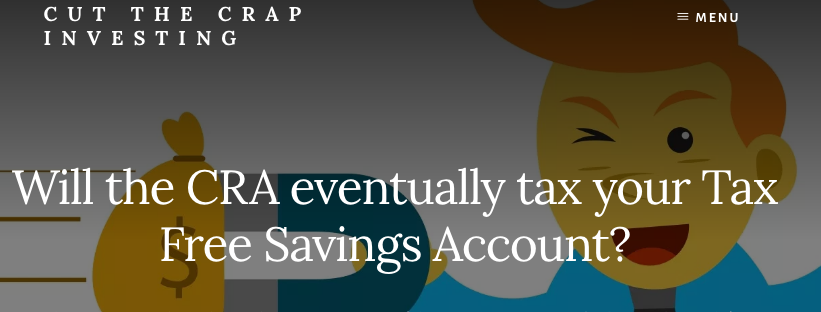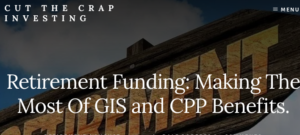By Dale Roberts, Cutthecrapinvesting
Special to the Financial Independence Hub
As it stands today the Tax Free Savings Account or TFSA is true to its name. It is tax free on all counts. The interest or income or capital gains created in the account are not taxed. When you take money out of your TFSA you pay no tax. Net, net, your money grows tax free and you can spend it tax free.
But will this change in the future when Canadians have amassed considerable sums and are able to generate significant tax free income in retirement? Will the CRA eventually tax your Tax Free Savings Account? The TFSA program was launched in 2009 with a maximum of $5000 of contribution space. The contribution allowance has been increased to reflect inflation and now sits at $6000 annual.

In 2019 it’s not uncommon to see a Canadian who has maximized their TFSA contributions and who has invested their monies sitting with a six figure balance. In fact they might even approach a balance of $110,000 or more in a TFSA. For a Canadian couple that is $200,000 or more in potential tax free income.
In another 10 years that couple could easily have a combined $500,000 in TFSA monies. Of course they’ll need the cooperation of the stock markets that have been more than generous over the last 10 years, especially if you throw that roaring US stock market into the mix.
A massive TFSA gives Canadian retirees options
When Canadian retirees begin to accumulate sizable TFSA accounts they can start to execute some very opportunistic retirement strategies. And that might include accessing the government program known as the GIS or Guaranteed Income Supplement. That’s designed to help lower income seniors.
In a guest post on Cut The Crap Investing Financial Planner Graeme Hughes outlined how spending our own RRSP monies can negate potential GIS payments and that is one of the most common mistakes made by Canadian retirees. From that post …
What’s less well-known is the impact RRSPs can have on lower-income seniors, particularly those retiring with only the Canada Pension Plan (CPP) and Old Age Security (OAS) amounts for pensions. In many cases these seniors would also get the Guaranteed Income Supplement (GIS), which is an add-on benefit to the OAS. However, the GIS is an income-tested benefit and RRSP withdrawals absolutely count as income for this purpose.
So often I have seen seniors withdrawing from their modest RRSPs in retirement while not realizing that, had they not been making those withdrawals, they would have been receiving valuable GIS benefits rather than drawing down retirement savings. By better allocating their resources prior to retirement they could have greatly improved their overall retirement picture.
And that seems like fair and needed financial planning for those with modest RRSPs. That’s all within the spirit of the OAS and the GIS program that is designed for retirees with lower incomes. But Graeme goes on to outline that some retirees with greater assets can also take advantage of the GIS program by using their TFSA accounts.
Even for wealthier retirees with substantial savings but no employer pensions, it is possible to obtain 7 years of GIS benefits by drawing down TFSAs or savings between age 65 and 71 and letting the RRSPs grow until mandatory withdrawals start at age 72. Those benefits can be worth tens of thousands of dollars and should absolutely be taken into consideration when planning for retirement.
TFSA withdrawals do not show up on your tax filing as income. The CRA only keeps track of your TFSA contributions and withdrawals. And certainly make sure you understand how the program works so that you can avoid any over contribution penalties. Here’s a link to the TFSA essentials on the CRA site.
Given that, a retiree could take out $20,000 for spending from TFSA ($40,000 for a couple) and those monies do not count as income. Those retirees only source of reportable income might be CPP and OAS payments – they might qualify for GIS or reduced GIS. But these retirees are certainly lower income seniors. They may have an owned-home worth $1 million or more, each with RRSPs in the $500,000 range (or more), those six figure TFSAs and perhaps some taxable investment accounts throwing off tax efficient dividend income that qualifies for the Canadian dividend tax credit. They might have a modest amount in a savings account that is earning very little and not greatly affecting their income statement.
These retirees might have a net worth of $2,000,000 or more and yet they still qualify for that Guaranteed Income Supplement. When that occurs, it’s totally legal and within the current rules, but it’s certainly not within the spirit of the GIS program designed to help lower income seniors.
Will most Canadians be outraged?
I’m guessing that most Canadians will be up in arms when they hear or read of this opportunistic financial planning. Jonathan Chevreau asked the question on Twitter and it generated a vigorous debate. Well that is, readers were already taking issue with the potential use of GIS for those with considerable assets. Continue Reading…






